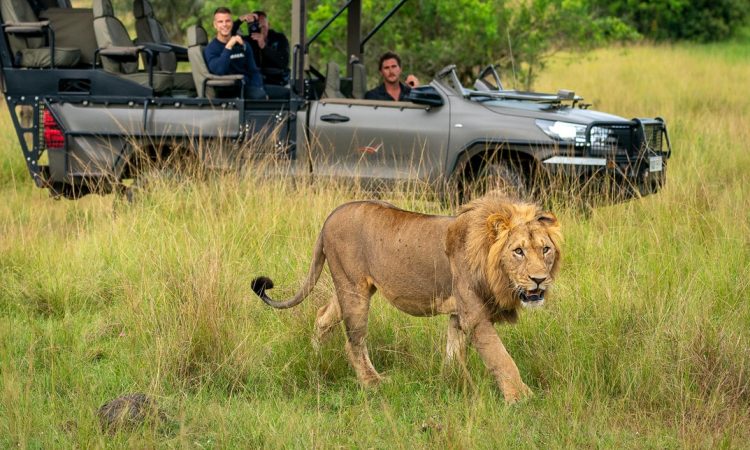The Tale Of Lions In Rwanda
The Tale of Lions in Rwanda: Rwanda is undoubtedly one of the most exciting travel destinations on the planet and a beautiful nation on the African continent. a must-visit location for Big Five Tours travelers to Rwanda. And the legend of the lions in Akagera National Park is maybe the most well-known narrative from Rwanda.

The “king of the jungle” has long since disappeared from Rwanda‘s untamed fauna. The last lion died in 1994, bringing an unfortunate end to these magnificent animals. For the next fifteen years, Rwanda was bereft of one of the most iconic animals in the world, until seven lions were successfully relocated back into the country in 2015.
Many of the Rwandans who had been uprooted by the genocide chose to live near national parks. Since the predator was invading their domain and harming both people and animals, their natural instinct as humans was to get rid of them altogether. They chased, poisoned, and murdered every last lion. This was to keep the lions from consuming their livestock. A nation home to more than 300 lions was in danger of going extinct very quickly.
The sudden disappearance of lions from the pastures serves as a sobering reminder of the atrocities the country has witnessed, and their return serves as a poignant reminder that things that may have been gone forever can be brought back to life.
Without lions, a lot may go wrong in the wild because they are crucial to maintaining the equilibrium of the ecosystem. It is crucial to conserve them for this reason. A significant transfer from South Africa in 2015 resulted in the arrival of 7 lions, who have now procreated to become over 35 cats.
In order to help manage the recreation area and revive the nation’s wildlife and tourism industry, the Rwandan government called African Parks, a conservation organization with extensive expertise restoring wild regions in Africa, for assistance in 2010. The future of Rwandan tourism was significantly impacted by the restoration of one of the Big Five Animals. Lions are found exclusively in Akagera National Park.
At first, there was concern about genetic mixing. Since the lions that were brought in were of the southern region. The lions who were once found in Rwanda were Eastern lions, and their genetic makeup is different from that of the Southern lions that were brought in later. This implies that they might act differently and find it difficult to mimic the new setting. But to everyone’s joy, these southern lions began to adapt to Akagera National Park’s new surroundings.
Shema, the oldest lioness to be brought into Akagera National Park, along with her two-year-old daughter Amahoro and their father, a five-year-old dominant male named Nshari, were among the lions that were brought in. Five females from Beyond Phinda Private Game Reserve and two males from Tembe Elephant Reserve and Ezemvelo KZN Wildlife Protected Area were among the translocated lions.
Although lions in Rwanda may appear to be the top predators in their area, a recent study that was published in The Journal of Wildlife Management reveals that there are several risks to these animals, such as habitat degradation and human conflict.
According to the study, there are currently more leopards than lions in Rwanda by a ratio of over two to one. However, if further steps are taken to protect them, the experts think that lion populations may rise again.
Researchers from the University of Kent’s Durrell Institute of Conservation and Ecology carried out the investigation.
According to the study, habitat degradation and confrontations with people are the main causes of the lions’ decline throughout most of their territory in Africa. Specifically, they discovered that lions may have ill health or injuries as a result of human-lion combat, which frequently increases the likelihood that they would pass away or get ill.
The absence of appropriate habitat for lions as a result of deforestation and other land-use changes was another finding made by the researchers. This increases their susceptibility to hyenas and leopards, among other predators.
There would only be one subpopulation of lions in East Africa if they became extinct in Rwanda. The safeguards that local communities and environmentalists provide for them will determine whether they survive to survive.
The only location in Rwanda where one can view lions is Akagera National Park. Large tracts of open grassland, vital to the survival of lions and other large herbivores, can be found in this park along with a diverse array of other animal species. However, poaching has also had a negative impact on the park recently, which has resulted in the removal of numerous species from the area, including lions. The government must act now to stop poaching incidents in the future and bring the ecology back into balance.
During the last 20 years, the number of African lions has decreased by almost 40%. They are currently in danger, partly as a result of habitat degradation and disputes with people. Less than 30,000 of them remain in the wild. But within the next several years, lions will go extinct if that trend persists. It is our responsibility to #fightforwildlifenow!
Every year, Rwanda experiences a rise in tourism, which implies that an increasing number of people are traveling to the country’s national parks to witness the animals firsthand. Lions are a major draw for visitors to the parks, and tourism generates a significant amount of revenue for the nation and thousands of employments in the tourism sector. For this reason, it is critical that we keep looking for ways to support their long-term protection.
